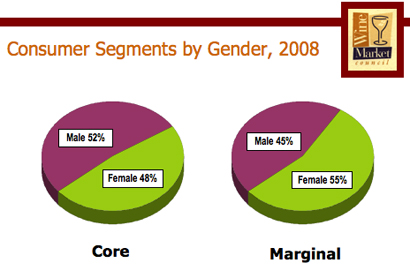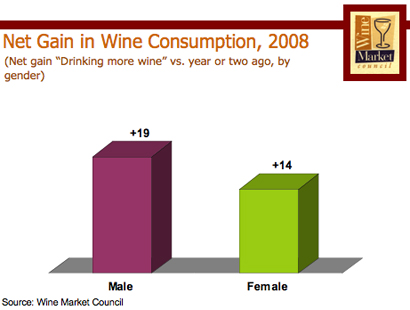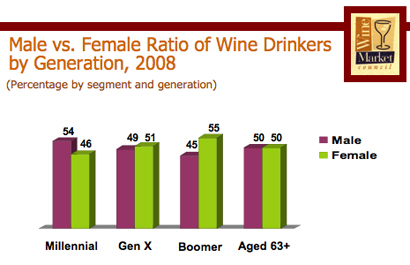The Sierra Gap – and more on American wine consumers
 People in California have a higher opinion of the quality and the value of wine produced in their state than do residents of the other 49 states. This phenomenon, dubbed “the Sierra gap,” (no, after the Sierra Nevada mountains, not Sierra Carche!) comes from the 2008 Wine Market Council survey. Fully 63 percent of Californians think that California wine offers better quality than similar wines as compared to 54 percent of respondents not from California. And in the question of value, the split was even wider at 73 percent versus 58 percent.
People in California have a higher opinion of the quality and the value of wine produced in their state than do residents of the other 49 states. This phenomenon, dubbed “the Sierra gap,” (no, after the Sierra Nevada mountains, not Sierra Carche!) comes from the 2008 Wine Market Council survey. Fully 63 percent of Californians think that California wine offers better quality than similar wines as compared to 54 percent of respondents not from California. And in the question of value, the split was even wider at 73 percent versus 58 percent.
This fascinating finding may bear upon our discussion of around the comments from wine importer Bobby Kacher about why so few tasty American wines under $12?
I asked John Gillespie, president of the the Wine Market Council how his survey data differ from the annual Gallup poll, which we discussed recently. As a reminder, our description on the Gallup wine drinkers: “If an alien landed in a room full American wine drinkers, it would meet mostly college educated, AARP eligible women, probably not from the midwest.”
Gillespie writes to describe how his results compare to Gallup:
You will see that among core wine drinkers (those who drink wine once a week or more often) there is a slight tilt in the direction of males. You’ll also see the a higher percentage of males are reporting an increase in their wine consumption. And when you look at the gender ratio by generation, you will see that younger groups are either gender neutral, or, in fact, skew male. So while the college educated AARP eligible female wine drinker does exist, we should keep in mind that just down the bar there are a couple of guys in their 20s drinking Malbec and texting their friends to come join them.
Among wine drinkers (also from the 2008 Wine Market Council survey of U.S. wine drinkers) is is true that a higher percentage of females (69%) say they prefer wine to other forms of beverage alcohol (56% of males say this). But
the reality is that among core wine drinkers (who account for about 90% of all wine consumed) there are more males than females, and that younger wine drinkers skew male, not female.
The Wine Market Council data also show that the youngest drinkers, a large generation younger than about 32 known as millennials, already consume the second most wine as a group and have the fastest growth rate at 46 percent. That’s quite a contrast to Europe, where younger drinkers are drinking less wine.
Slides after the jump.



The Wine Market Council describes itself as “a non-profit association of grape growers, wine producers, importers, wholesalers, and other affiliated businesses and organizations. The council’s mission is to establish the widespread acceptance of wine as a rewarding part of American culture and to encourage the responsible enjoyment of wine by current and future generations of adults in the United States.”




On July 24th, 2009 at 3:08 pm ,tallywineguy wrote:
The Sierra Gap is unsurprising–typically people have a preference the familiar and the local. Its partiality. Only someone who drinks (roughly) the same amount (and quality, etc.) of local and non-local wines is a good judge of which are best.
On July 24th, 2009 at 4:25 pm ,Corked wrote:
Surely there is an element of “homerism” here, but there might be some legitimacy to the Californian’s thoughts. CA wine is likely cheaper in CA than in the midwest or east coast, and there is likely a greater variety available, and with that greater quality, on average.
On July 24th, 2009 at 5:57 pm ,Charlie Olken wrote:
Does CA wine cost less at home? I have no statistics on that but my non-scientific sense is that I find many CA wines higher priced east of the Mississippi.
By the same token, there is a much greater supply of European wine along the eastern seaboard and in Texas than in the west. Part of that is directly attributable to the homerism preference for CA wines out here. Part is attributable to the fact that there are clustered major markets back East and they are easier to reach for Europeans trying to get into the US market.
And then there is this. The information provided by the Council, which is heavily weighted to CA wine in membership so no one out here can claim anti-CA bias, is a snapshot in time. It may well be that there have been tectonic changes in the image of CA wine east of the Sierras, or Denver or the Mississippi over the last several decades and that the numbers are not necessarily a downer for CA wine.
And finally I wonder what happens when Chile, Argentina and Australia are taken out of the equation. To a very large extent, those countries did not exist as competitors for bargain wine back several decades.
On July 24th, 2009 at 7:59 pm ,C Moses wrote:
Let me second the comment from “corked” with vigor.
If you shop at Safeway, or any of dozens of discount wine retail shops here in California, our own wine is 10-30% under suggested retail- in other words dirt cheap.
But on the East Coast, I usually find California wines priced at or above suggested retail, and the stores mark down European wines. Those price differentials dramatically tilt the value choice.
On July 26th, 2009 at 6:48 am ,Susan wrote:
My experience living in New York City for the past 30 years is that women are much much more likely to drink wine than men. Men are much much more likely to drink beer than the women. In addition, if a man has to choose a wine in most cases it will be a red, as white wines are viewed by most men I know as more wimpy and not as tasty as reds. I have gone to wine classes in Manhattan for years and most of the attendees are female.
On July 26th, 2009 at 7:12 pm ,Dylan wrote:
Why is it that Millenials have the largest skew of male to female wine drinks? Data is fine but what I care about is the interpretation and conclusions can be drawn from it. From this, I still feel a little lost on why the numbers are what they are.
On July 27th, 2009 at 12:56 am ,Roger wrote:
I have to agree with the idea that many wineries in California tend to think their wines are the standard bearer for American wine. This may have to do with the fact that 75% of wines made in the US come from the Golden State. It is also to their advantage to maintain this image.
The Wine Marketing Council is a California base agency as you state, funded largely by California wineries. This is a good reason to look deeply at the conculsion. The wording used in any study can guide the participants into a particular direction and not knowing the specific questions make it difficult to make a sound judgment. The Wine Marketing Council is a good organization, I know many of their people, but it is a marketing agency.
Wine consumption is on the rise throughout every demographic and while I do think that males historically have made up the bulk of regular wine drinkers, my own experience shows that more and more females are becoming interested in wine appreciation. It is all good for the industry regardless.
Great wine is being made throughout the country but most of these wine growing regions are relatively small compared to the acreage under vines in California. California also has a mature infrastructure to market their wines more effectively.
The good news is that we are seeing tremendous bargains as the current glut reaches critical mass. Deep discounts in order to offload the last vintage to make room for the current one, as well as generate operating capital are becoming common. Hopefully, these price reductions will find their way to your local wine shop.
The bottom line is that most Californians drink California wine. The ‘gap’ is not surprising given that it is what they know. It is also very hard to find Finger Lake cab anywhere on the west coast.
Cheers!
On July 27th, 2009 at 10:22 am ,James wrote:
As for value, isn’t it always cheaper closer to the source?
On July 28th, 2009 at 2:57 pm ,Nick wrote:
The Sierra Gap is about liking what’s local (true most everywhere) and Californians’ generally healthy self-image. And liking what’s local is a two-way street. Local preferences influence what gets sold thus what gets made. Then local products enjoy higher esteem in surveys and this reinforces the trend. I hazard to guess that the [Italians] have a healthier view of the quality and value of [Italian] wines vs. French wines. Ditto Texas, ditto Washington, ditto Oregon, etc.
The WMC is not using this info to inflate the importance of CA wine quality or value, so we should dispense with the comments about this being biased. If anything, the WMC is using this info as a bubble-burster for industry insiders who, like those politicos too long in Washington DC, may be out of touch with the rest of the nation.
Also, note that this survey info is presented about quality and value separately, so simply looking at the regional price differences (thus differences in value) of the wine doesn’t explain away this trend in terms of quality, even though it does legitimately bear on value as another commented rightly pointed out.
On July 28th, 2009 at 3:53 pm ,CorkPopper wrote:
As a female “Millenial” from California, I think I may be able to speak to at least a couple of the points made in this post.
As several commenters have noted, California wine is not only less expensive in California, but it is getting easier and easier to find a vast variety of quality wines at lower price points virtually everywhere you go. For example, you can find quality (and still inexpensive) California wines at most major grocery stores these days. And to top it off, most will give you an additional 10% discount when you buy any six bottles.
This general availability of quality (yet inexpensive) wines is, I believe, feuling the increase in wine consumption among younger Americans, especially Californians. We are, for better or worse, a generation of individuals who are unlikely to be satisfied drinking the same thing every day. We have been exposed to innumerable choices our entire lives and are therefore more adventurous than our parents when it comes to what we eat and drink.
Finally, (and I readily admit that what I’m about to say may sound a bit sexist) the fact that the Millenial wine-drinking population is skewing slightly male these days has, in my experience, at least something to do with the fact that young men go where the young women are, and many young women can be found on your average Thursday or Friday night at their favorite wine bar…. or maybe that’s just my group of friends….
On July 28th, 2009 at 4:10 pm ,Charlie Olken wrote:
As a red-blooded male from California with a wine cellar that can keep us both in new choices for years to come, I want to know where you and your friends hang out.
Oops, never mind. I have gym socks that are probably older than you.
On August 2nd, 2009 at 7:54 pm ,Best Wine Blog Posts for July 3rd through July 30th | Winecast wrote:
[…] The Sierra Gap – and more on American wine consumers […]
On August 3rd, 2009 at 1:35 pm ,Greg wrote:
Like others said, it’s a bit of chauvinism and a bit of economics. Many of the smaller high quality brands simply don’t get distributed much outside of California. Much of the cheaper good stuff doesn’t leave the region, and there are minimal transportation costs. There’s probably less travel and heat stress on the wines as well, meaning they’re less likely to be compromised in the distribution chain.
That at least makes the quality vs. value ratio competitive within California. On the east coast, CA is certainly more expensive, and France cheaper.
On June 18th, 2011 at 4:16 pm ,John Gillespie wrote:
I’d like to address the concern raised by Roger. While Wine Market Council is based in California, it is not funded exclusively by California wineries and its membership includes major U.S. distributors such as Southern Wine & Spirits, Glazer’s, and the Charmer-Sunbelt Group. We also have many imported wine companies such as Winebow and Deutsch. And our members include wineries outside of California, like Chateau Ste. Michelle in Washington and Biltmore Estate in North Carolina, as well as trade associations such as the Washington Wine Commission and Wines from Spain. We represent everyone who sells wine in the U.S., from all states and all imported sources, so there is no bias. If we were influenced by California wineries, we would not have announced the fact that Americans outside of California have decidedly lower opinions of the quality and value of California wines, compared to Californians. The facts are the facts, and we report them faithfully.